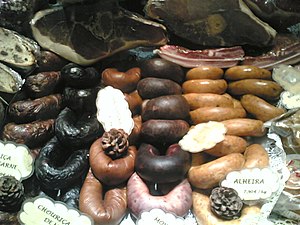Translations:Portuguese cuisine/33/en
In 1878, Macedo Pinto described the bísaro pig as an animal belonging to the Typo Bizaro or Celta, with the morphological characteristics mentioned above, distinguishing two varieties within the breed, according to the corpulence, color and greater or lesser amount of bristles.

He considered the existence of pigs from 200 to 250 kg of carcass and others between 120 and 150 kg; as for color, he says they are mostly black, also some spotted and those with white fur were called Galegos, as they come from Galicia. Molarinhos were spotted animals that had few bristles and smooth, smooth skin. The same author also mentions that they are animals of slow and late growth, difficult to fatten (only completing their growth at the age of two), producing more lean meat than fat and accumulating more in the fat than in thick blankets of bacon. In 1946, Cunha Ortigosa classifies the Bísara breed, originally from the Celtic family, as one of the three national breeds. When describing the varieties within the breed, in addition to Galega and Beirôa which encompasses the Molarinho and Cerdões subtypes.